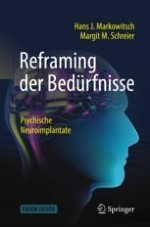2019 | OriginalPaper | Buchkapitel
6. Psychische Neuroimplantate – Wie kann Lebensverbesserung im Gehirn tatsächlich wirksam werden?
verfasst von : Hans J. Markowitsch, Margit M. Schreier
Erschienen in: Reframing der Bedürfnisse
Verlag: Springer Berlin Heidelberg
Aktivieren Sie unsere intelligente Suche, um passende Fachinhalte oder Patente zu finden.
Wählen Sie Textabschnitte aus um mit Künstlicher Intelligenz passenden Patente zu finden. powered by
Markieren Sie Textabschnitte, um KI-gestützt weitere passende Inhalte zu finden. powered by
